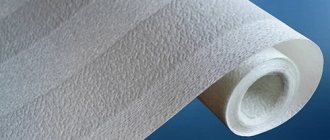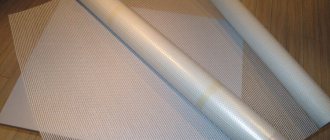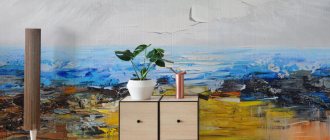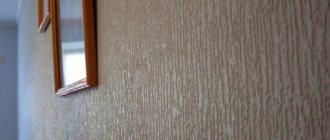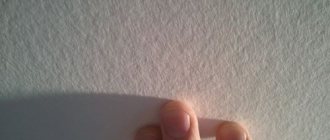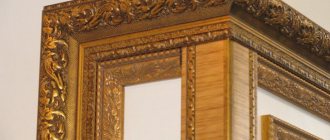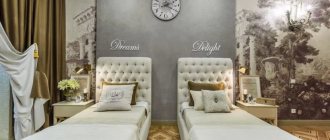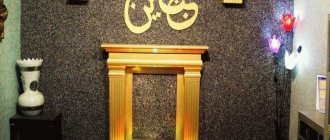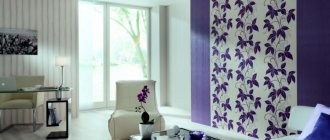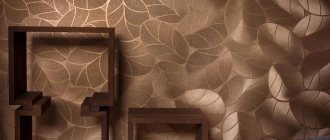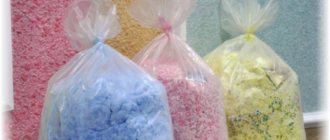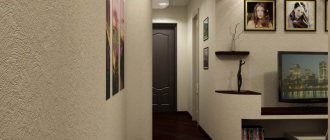Photo: toolboxprodhouse.com
And such wallpapers also differ in the quality of production - their price and ease of gluing directly depend on this. There are two varieties:
- 1st grade wallpaper - sold in strips of solid 25-meter canvas with a perfectly matching pattern;
- 2nd grade wallpaper is cut from different fabrics, so the geometric pattern on their surface, although it will be the same, may end up being non-uniform at the joints. Such wallpapers are cheaper, but may also have manufacturing defects.
Photo: plissee-guenstiger-kaufen.de
As for color, it all depends on the desires and ideas of the buyer - after all, all glass wallpaper is produced for painting and initially has a white, clean surface. To paint them, special paint of any color is purchased. So glass wallpaper can be completely customized to suit your interior.
What is glass wallpaper?
Fiberglass wallpaper is a finishing material for walls consisting of impregnated fiberglass. The surface has a relief pattern. Fiberglass wallpaper is made from glass blanks that melt under high temperature and the fibers stretch.
These are subsequently used to create threads, and then fabric or fiberglass using the weaving method. Later, the surface is coated with impregnation to ensure the stability of the material.
Application of web
Almost every surface, be it a ceiling or a wall, needs finishing. In order to make this process much easier, fiberglass is glued. When using it, the need to use starting putty is completely eliminated. Experts recommend using this type of finishing material without fail for those surfaces that are very often subject to mechanical damage or there is a risk of cracks. Fiberglass can strengthen these surfaces, and this is possible due to the fact that it is incredibly strong and durable. Most of all, this type of material is suitable for finishing the ceiling surface. It is very important to take into account that it can be glued to almost any wall or ceiling. For example, this reinforcing material can be used to strengthen surfaces such as concrete, plastered, made of plasterboard, and so on. As a result, you will get a very smooth surface that can be finished at your discretion, for example, painted, puttied, wallpapered, and so on.
Compound
Fiberglass wallpaper consists of natural materials: soda, clay, limestone, quartz sand. To transform from blanks into fiberglass, only high temperatures are required, reaching 1200 degrees.
The basis of the impregnation, which is applied upon completion of the work to ensure the durability of the material, is modified starch.
Specifications
- Service life more than 30 years
- Possibility of coloring Coloring up to 20 times
- Standard size, (m.) 1x25; 1x50
- Static electricity does not accumulate
- Vapor permeability level High
- Fire properties Yes
- The minimum density of wallpaper for wall decoration is 100 g/m2. m.
Advantages and disadvantages
The advantages of this finishing coating include:
- Strength. Fiberglass wallpaper is distinguished by its high strength from other finishing coatings. They do not tear, do not scratch or become deformed. It is worth noting that the material tolerates the effects of all chemicals during wet cleaning.
- Favorable microclimate. The structure of the wallpaper consists of small loops that help water vapor move between them with ease. This “knitted product” does not attract dust and prevents the accumulation of static electricity.
- Environmentally friendly. This finishing coating consists of a special type of glass that is safe for others, and it also does not allow harmful microorganisms to multiply.
- Sustainability. The coating is not prone to mechanical damage. It does not deform when in contact with hands or in contact with furniture. If necessary, you can replace the damaged fragment using horizontal gluing.
- Easy to paste. In order to cover walls with fiberglass wallpaper, you do not need to have special skills.
- Fire safety. Resistant to high temperatures.
Disadvantages:
- Price. Depending on the image and texture, the cost of such a canvas may be inflated.
- Specialist. cloth. To carry out repair work, you will need to purchase special protective clothing. This is necessary so that when pasting the walls, microparticles of glass fiber wallpaper do not get on you, which can lead to irritation or allergies.
- Paint costs. Fiberglass wallpaper is highly absorbent, so to paint a wall you will need a large amount of paint.
Qualities and advantages
The technical features of the product and its advantages were determined by professionals and ordinary buyers.
Environmental friendliness
When it comes to high-quality wallpaper, manufacturers use exclusively safe and natural raw materials. Due to this characteristic, the finish can be used to decorate children's rooms, as well as in houses where allergy sufferers live.
This is a significant advantage compared to products made from artificial substitutes and chemical components.
Special texture
Fiberglass wallpaper is a breathable material. Due to the air permeability, comfortable conditions are created in the room. Excess moisture, which causes the formation of fungus and bacteria, does not accumulate under and on the finish.
Antistatic
Due to its special composition, wallpaper does not accumulate an electrical charge, since glass does not conduct electricity. Thanks to the special effect, the cleaning process is much easier, because dust practically does not accumulate on the surface. This is also a plus from an aesthetic point of view.
Reliability and durability
The glass fiber material boasts its durability. The service life of the canvas is many times greater than that of wallpaper made from other materials, such as paper or fabric. On average it lasts about 30 years.
Wallpaper is also practical and wear-resistant, does not require special care, and is not susceptible to damage from the paws of pets or a bicycle.
Fire resistance
Fire safety is very important regardless of the significance of the facility. The melting point of glass is 1300 degrees Celsius. Considering this fact, wallpaper made from the above material cannot cause a fire.
When exposed to open fire and high temperatures, the material does not emit harmful substances that are dangerous to others.
Possibility of painting
Canvases can be painted many times without destroying their texture and density. Most manufacturers guarantee 20 paint jobs. Due to the treatment with enamel, the canvas acquires the required shade. This is an important factor in the interior design of houses and public institutions.
Removal
Removing the remnants of the old coating from the walls is very problematic. For complete removal you will need many tools and a lot of time. This significantly prolongs the renovation, especially when it comes to the design of large premises.
Slicing
If you have to cut the wallpaper, you will notice that the glass fibers will begin to crumble. To avoid damaging your skin during work, use a special mask and glasses.
Paint consumption
To decorate walls with such wallpaper, you will have to spend more paint than when working with paper and other wallpapers widely known on the market. The reason for the increased consumption is the high relief and texture.
Defects
The texture of the canvas can be changed after the first painting. However, this disadvantage only exists with low-quality finishes.
Expenses
If you decide to carry out finishing work with the help of qualified craftsmen, this will be an additional cost. The whole process is divided into 2 stages: wallpapering; painting.
Finishing
Before installing the topcoat, the ceiling must be puttied again because:
- wallpaper, especially heavy ones, does not adhere well to the web;
- the texture of the fiberglass will be visible under the layer of paint;
- fiberglass fabric actively absorbs moisture, which increases the consumption of wallpaper glue and paint (sometimes 3 or more layers are required).
Therefore, the dried fiberglass is primed and coated with finely dispersed finishing putties based on polymers - latex, acrylic. The compositions are not cheap, but the consumption for 1-2 layers will be insignificant, since the surface is already smooth, and the mixture is quite plastic and is well distributed in a thin layer.
Puttying is carried out as follows:
- Apply a primer to the fiberglass and wait 1–6 hours.
- Putty is applied to each joint in 2-3 layers up to 1 mm thick, the last time with the finishing product. Then the entire ceiling is treated.
- After a day, grinding is performed with fine sandpaper or silicon mesh.
- Apply primer.
On glass fiber you can achieve the effect of a mirror surface. To do this, the putty is diluted a little more than usual and applied with a rubber spatula in a layer of 1.5-2 mm. 12 hours after the mixture has dried, the procedure is repeated.
Painting is often chosen as a finishing touch. For this purpose, water-dispersion paints are recommended:
- acrylic;
- latex;
- silicone.
The coating is applied twice to obtain a dense layer without streaks. To do this, you will need a roller with medium length bristles.
The cost of fiberglass canvas can seem high, so it's tempting to make repairs on the cheap. But this is a case where the miser pays twice. After all, if you ignore covering with cobwebs, the ceiling will quickly crack, especially in a new building, and you will have to spend money on repairs again.
Features of glass wallpaper
Even the best glass wallpaper has its own characteristics, which are best known before purchasing. First of all, you need to purchase special glue for the job. In addition, it is better to choose the paint in advance, because... Not all paints are suitable for this coating.
In addition, in rare cases, it may be difficult to dismantle the coating; it depends on the wall.
Fiberglass wallpaper is a solution that allows you to take a new look at wall decoration. Now that all the advantages and features of this material are known, all that remains is to visit the supermarket and make your most cherished dreams come true, and the photos of glass wallpaper in the interior from this article will be an excellent help in realizing your ideas.
Feel free to color your life with this amazing material.
conclusions
As you can see, gluing fiberglass, painting and puttying the surface between these two processes is the only suitable option for obtaining not only a durable, but also a smooth and attractive-looking wall. At the same time, the work does not require much more time than the usual finishing of enclosing structures, and the result is noticeably different for the better. The reasons for choosing the option without wall putty can only be the need to save money with a limited budget and low requirements for the quality of painting, since an attempt to obtain a high-quality result in this case will lead, on the contrary, to overspending on paint and loss of quality.
Criteria for choosing glass wallpaper for painting
The peculiarities of glass wallpaper production sometimes make it difficult to choose. It may be impossible to visually distinguish high-quality products from defective ones. Knowledge of selection methods does not help either. For example, the density and thickness of the material can be increased by impregnation.
But this will definitely have an effect during the pasting process - the canvas tears, deforms, loses elasticity, and sometimes decreases in size. As a result, the clarity of the drawing is disrupted.
The ideal solution to the problem is to cut a piece from the roll, stick it on a solid base (not advisable on the wall, because if the quality is good, it will take a long time to peel it off), let it dry, and paint it. The test is completed by pressing the spatula onto the trellises. If they are not deformed or change their appearance, the quality is high.
If this is not possible, the choice should be made according to the following parameters:
- density;
- composition;
- class;
- pattern.
Density.
The density criterion determines the durability of the trellis. There is a direct relationship here: the denser, the longer the service life.
Wallpaper with a density of over 100 g/cm2 is considered high quality. But this is the lower limit of the indicator. You need to focus on the figure of 150 g/m2 (European manufacturers have a standard value of 145 g/m2). Deeply patterned fiberglass fabric (jacquard) can be even heavier, up to 220 g/m2.
But here, as with any rule, there are exceptions. For the ceiling, 25 g/m2 is enough - that’s how much smooth cobwebs weigh. But for walls, the web canvas should have an indicator of 45-50 g/m2.
Compound.
Many buyers underestimate such a selection criterion as composition. But in vain. The strength and durability of the finish depend on the indicator. At the same time, deviation of the ratio of 70% fiberglass to 30% impregnation in any direction worsens the consumer characteristics of the finishing material.
Information about the composition should be on the insert. Its absence should alert the buyer.
Class.
On the insert you can also find the class of wallpaper (Russian manufacturers indicate the grade, which is the same thing). You need to buy first class fiberglass trellises. When purchasing second-rate decor, the density must be at least 100 g/m2.
Pattern.
For the ceiling you need smooth wallpaper - cobweb. For the walls, the pattern is chosen depending on the taste of the owners (“matting”, “herringbone”, “drops”). At the same time, a pattern with greater depth can be repainted more times - the pattern will be preserved.
Popular manufacturers and prices
A well-known brand can guarantee quality. Among them are many world-famous companies producing fiberglass wallpaper:
- "Vitrulan";
- "Tassoglas";
- "Nortex";
- "Welton"
- "Oscar"
- "Bau Master";
- "X - Glass";
- "Saint-Gobain Novelio";
- "Waltex"
- "Veterman"
- "Mermet" etc.
"Vitrulan".
Fiberglass wallpaper under the Vitrulan trademark is produced by the German concern Vitrulan Textile GMbH, the largest manufacturer in Europe. The company's technologists are constantly working to create a variety of lines of trellises, as a result of which they are distinguished by their smoothness, types of patterns, softness and color. And all this with quality that is commonly called German. The base price per 1 m2 ranges from 170-468 rubles.
"Tassoglas".
The product of an American company with its factories in the USA, Europe and China. It achieved fame thanks to the widest range of surface textures among similar productions. Practical and high-quality fiberglass is used not only for finishing offices and organizations, but also for covering walls and ceilings in living rooms.
Rarely found on sale. Costs from 82 to 450 rubles/m2, depending on density.
"Nortex".
"Nortex" is a trademark of a Russian company. Production is located in China. Takes into account the requests of all buyer groups. Therefore, on the market you can find both premium-class wallpaper with a high density of 200 g/m2, and economy-class wallpaper with a density of up to 100 g/m2. They are distinguished by durability, a guarantee of over 30 years and a variety of patterns.
The price range is significant. You can buy it for 66 rubles/m2 (“Medium matting”), and for 168 rubles/m2 (“Rain”).
Welton.
A Swedish brand with established production in many countries of the world: Germany, Russia, Czech Republic, Finland and China. All production facilities produce high quality products with stylish design. The cost of 1 m2 is about 208 rubles.
"Oscar".
Subsidiary, but with more affordable prices and good quality - 69-107 rubles/m2.
"Bau Master"
China. They are distinguished by affordable prices and good quality. The cheapest wallpaper can be bought for around 33 rubles/m2, the most expensive - 130 rubles/m2.
"X - Glass."
Russian manufacturer with a wide range of glass fiber and canvas in the middle price range. For example, fiberglass fabric can be found on sale for 47-80 rubles/m2.
If we consider specific wallpaper models, their rating for mid-2022 is as follows:
1. "Vitrulan Acoustic 904 Labyrinth". The wallpaper is unique in that a layer of heat and sound insulation is applied to the reverse side (reduces noise by about 2 times).
Their density is 610 g/cm2, dimensions are 10.4 x 0.96 m, price is 20,866 rubles. per roll.
2. "Vitrulan Aqua Plus 604 phantasy microcrepe." The highlight is that there is no need to select a design or buy glue - it is already applied to the back side.
Density - 200 g/m2, dimensions - 1 x 25 m, price - 9400 rubles. per roll.
3. "Brattendorf B021 Rain." German quality products costing about 9,360 rubles.
4. "Novelio Checkers 1023". Czech glass wallpaper 25 m long, density 195 g/m2, priced at 4,078 rubles per roll.
5. "X - Glass Gold." Finishing finishing material with a price of 3200 rubles. per roll.
Recommendations from experts
Before you begin the actual finishing work, you need to learn a few tips from professionals:
- Typically, a material with a lower density is used for finishing the ceiling, and a material with a higher density is used for walls. This is very important to take into account when choosing fiberglass, since otherwise the finishing process can become very complicated.
- It is also important to choose the right and very high-quality glue. You shouldn't skimp here. If you choose a low-quality or unsuitable adhesive, this can negatively affect the final result and significantly reduce the time between repairs.
- When gluing the ceiling surface, it is very important to use a reliable stepladder. Please note that a ladder is not suitable in this case, since both of your hands must be completely free.
- It is necessary to work with fiberglass very carefully. You should avoid deforming this finishing material, as this will have a very negative impact on the final result.
Painting fiberglass web is becoming more and more popular every year. And if you do not make mistakes when carrying out finishing work, then the result of your work will delight you and your guests for many years. And to change the design, you just need to repaint the walls or ceiling in a different color or stick new beautiful wallpaper.
How to properly paste glass wallpaper for painting
Glass wallpaper in the interior can look different, it depends on the chosen color, pattern, texture, etc. In many ways, the appearance of your room depends on how they are glued. In order for this process to take a little of your time, and to avoid any problems with gluing them, you need to know some features:
- when you start gluing the coating in question, you must remember that the glue is applied directly to the surface of the walls and ceiling, the wallpaper does not need to be coated with an adhesive;
- For such purposes, you need to purchase special glue; regular glue will not work, because this type of wallpaper is much heavier than similar wallpaper. You can buy it ready-made or in powder form;
- before gluing glass wallpaper, you need to find out where the front side is on them; in appearance, the sides are very similar;
- This coating dries in about a day, so during the drying time of the wallpaper it is necessary that there are no drafts in the room;
- after complete drying, you can start painting them;
- Wallpaper must be glued end-to-end, starting from the corner.
Pasting process
After the finishing material and the surface to be glued have been prepared, you can proceed to the actual finishing process. You should simply apply a strip of fiberglass to the wall and smooth it out with a rag or your hands. Finally, smooth the surface with a spatula, while trying to remove all the air from under the glued material. After you are sure that the strip is securely stuck, you will need to use a sharp knife to remove all excess. And only after this can you begin to apply the adhesive directly to the front side of the material. It should be completely saturated with glue, so that its color over the entire surface becomes dark from moisture. Then you can start gluing the next strips, keeping in mind that they are glued overlapping. It is better to make the strips the same size if possible. And professionals advise pasting the ceiling exclusively along the room. After the second sheet is coated with glue, you need, armed with a very sharp knife, to cut a straight line in the place where the overlap is made. And then you will need to remove everything unnecessary so that you end up with a perfectly flat surface.
What and how to paint then
Dried wallpaper undergoes a finishing operation - painting. For this, water-based or water-dispersion acrylic paint is best suited.
You need to paint after the wallpaper is completely dry (the time is indicated on the glue packaging). But before this, it is necessary to prepare the room so that splashes of paint do not get on the floor and furniture, apply a primer to the fiberglass - this will reduce paint consumption and improve its adhesion to the trellises.
You can prime with a special primer or heavily diluted wallpaper glue.
Painting is carried out with a small paint brush, initially in hard-to-reach places, such as corners and joints of the wall with the floor and ceiling, and only then with a roller over the entire canvas. Drips are removed with a used roller.
When passing the joints of the sheets, be sure to grab the next sheet to avoid visible seams. After the first layer has dried, the second is applied.
In conclusion, the use of fiberglass wallpaper for decorating an apartment or house allows you to create a durable finish with the possibility of regular renovation of the interior (if all operations are performed correctly, glass wallpaper will last more than 30 years).
The gluing and painting technology does not contain anything complicated - the work can be done on your own.
The nuances of gluing drywall with fiberglass web
It is very common that the surface of the ceiling or walls is finished with plasterboard. In order to strengthen and prevent surface deformation, fiberglass is also used. However, there are a couple of important nuances in gluing such a surface with this type of finishing material.
- First of all, you will need to coat all joints and places where screws enter with putty. As a result, you should have an almost perfectly flat surface. Be sure to wait until the putty is completely dry.
- Then you will need to coat the entire surface of the drywall with glue - this is the primer layer. And you can start finishing the surface with a “cobweb” only after the glue has completely dried. By the way, you must use an adhesive that is specifically designed for this type of finishing material. Next, pasting is carried out according to the above scheme.
Wallpaper color
Designers divide wallpaper not only by technical characteristics, but also by aesthetic effect and color.
- Light wallpaper. White and beige canvases are often used as a base for painting. This is a great neutral background for any colors.
- Colored canvases. Buyers are offered a huge range of colors to choose from, differing in saturation and brightness.
Use to strengthen the ceiling
Fiberglass is used as a reinforcing element when additional strengthening of surfaces is necessary.
The fiberglass sticker on the ceiling is carried out in the following order:
- remove the old finish, level, putty and prime the ceiling;
- measure and cut pieces of suitable size from the canvas, leaving a small margin;
- fiberglass is glued to the ceiling end-to-end or at a short distance of the elements from each other;
- smooth the material from the center to the edges with a plastic spatula;
- After the entire surface of the ceiling is covered with cobwebs, its excess edges along the walls are carefully trimmed with a stationery knife.
Water resistance
On the market you can find 3 categories of glass wallpaper depending on their water resistance.
This designation is marked using a wave-shaped pattern.
- One wave. Lowest moisture resistance. Such canvases should be cleaned as carefully as possible, without pressing hard on the canvas. Use suede.
- Two waves. Average value. You will not damage the material by wiping it with a damp cloth.
- Three waves. The highest rate. The wallpaper will retain its density even when cleaned using household chemicals. This wallpaper is recommended for kitchens and hallways.
Photo ideas in the interior
For the bathroom
Fiberglass wallpaper will be a good finishing option for a bathroom. They are not afraid of moisture and will not allow fungus and mold to appear.
For greater strength and reliability, the fiberglass fabric is coated with washable paint.
For kitchen
A big advantage can be considered the high fire resistance of glass wallpaper.
In the kitchen, this fact is very relevant. At high temperatures, fiberglass sheets do not emit harmful substances. In addition, replacing glass wallpaper will cost less and the work will be easier. Suitable for finishing the dining area.
In the toilet
In the toilet, as well as in the bathroom, it is important to minimize the possibility of mold and mildew. Fiberglass wallpaper will help with this; they will be a good alternative to tiles. In addition, their cost is lower than tiles.
In the hall
The strength of the fiberglass material will eliminate mechanical damage to the surface, and the waterproof coating is easy to care for and keep clean.
On the balcony
Fiberglass wallpaper is not afraid of changes in temperature and humidity; it will be a practical solution for finishing a glazed balcony or loggia.
Tips for caring and washing wallpaper
The glass wallpaper material itself is quite durable and can withstand various cleaning methods. The method must be selected depending on the paint covering the surface.
- Non-abrasive detergents can be used to remove stains from the glass cloth surface.
- depending on the moisture resistance of the paint, you can use soft suede or a brush,
- For preventive maintenance, it is enough to remove dust with a dry soft brush.
Photo gallery
Glass wallpaper is a practical and at the same time beautiful method of interior decoration. The high strength of fiberglass material allows you to decorate any room, and the safety of their composition makes it possible to decorate a children's room or balcony without worrying about the release of harmful substances.
At the same time, the material breathes and protects against mold.
